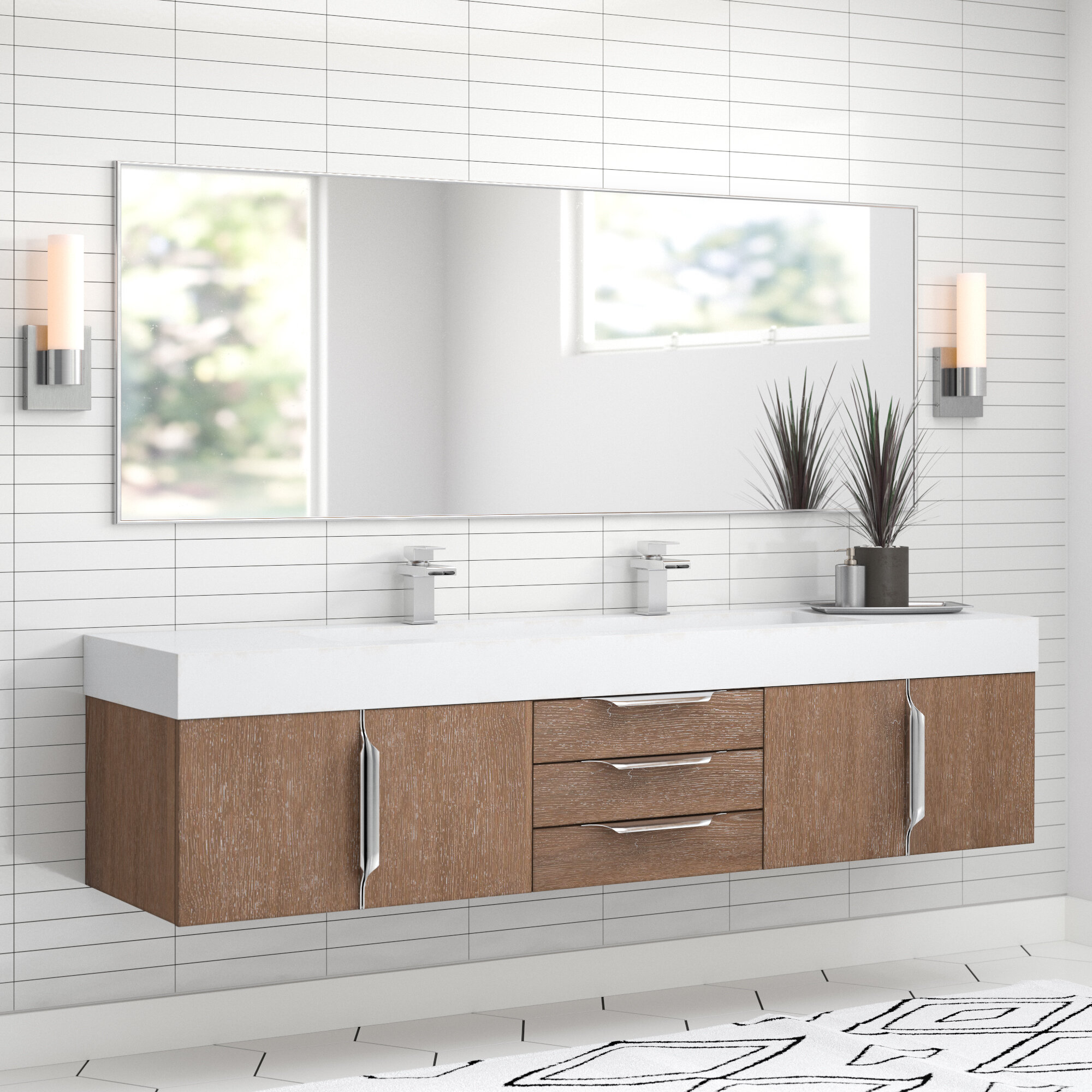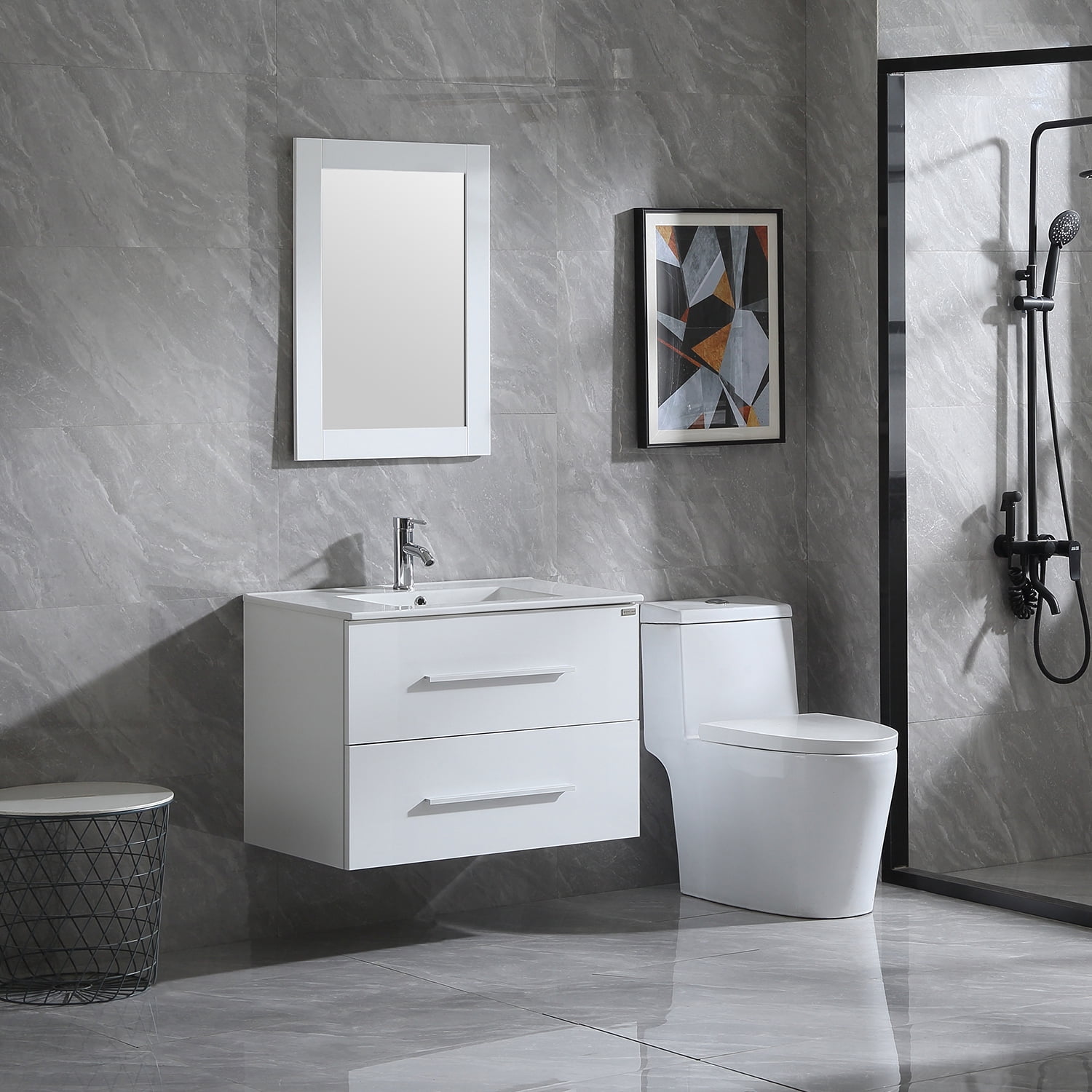Bathroom Hanging Vanity Units

Bathroom hanging vanity units offer a stylish and practical solution for modern bathrooms. These units, suspended from the wall, create a sense of spaciousness and ease of cleaning. Compared to traditional floor-standing vanities, they provide a cleaner look, enhanced accessibility, and greater flexibility in bathroom design.
Advantages of Hanging Bathroom Vanity Units
Hanging bathroom vanity units offer several advantages that make them a popular choice for modern bathrooms.
- Enhanced Space: By eliminating the need for legs, hanging units free up valuable floor space, making the bathroom appear larger and more spacious. This is particularly beneficial for smaller bathrooms where every inch counts.
- Easy Cleaning: The absence of legs or baseboards makes cleaning beneath the vanity unit significantly easier. This eliminates the need to move heavy furniture and allows for thorough cleaning of the floor.
- Accessibility: Hanging units are generally lower to the ground, making them more accessible for individuals with mobility issues. This also makes it easier for children to reach the sink.
- Versatility in Design: Hanging units offer greater flexibility in design and placement. They can be installed at various heights and positions to accommodate different bathroom layouts and preferences.
- Modern Aesthetic: Hanging vanity units contribute to a contemporary and sleek bathroom design. Their minimalist aesthetic complements modern bathroom fixtures and décor.
Disadvantages of Hanging Bathroom Vanity Units
While hanging bathroom vanity units offer numerous advantages, there are also some potential drawbacks to consider.
- Installation Complexity: Installing a hanging vanity unit requires careful planning and precise measurements to ensure stability and proper support. It may necessitate professional installation for optimal results.
- Weight Restrictions: Hanging units have weight limitations, so it’s crucial to choose a unit that can adequately support the weight of the countertop, sink, and storage items. Overloading can lead to structural damage.
- Wall Strength Requirements: Hanging units require strong and stable walls for proper support. Walls made of drywall or plaster may require additional reinforcement to handle the weight of the unit.
- Limited Storage: Some hanging units may offer less storage space compared to traditional floor-standing vanities. This is especially true for smaller units.
- Cost: Hanging vanity units can be more expensive than traditional floor-standing vanities, particularly those made from premium materials and featuring complex designs.
Materials Used in Construction
Bathroom hanging vanity units are constructed from various materials, each offering unique properties and aesthetics.
- Wood: Wood is a popular material for vanity units, offering durability, natural beauty, and warmth. It’s available in various species, including oak, maple, cherry, and walnut, each with distinct grain patterns and colors. Wooden vanities can be stained or painted to match the bathroom’s décor.
- Acrylic: Acrylic is a synthetic material that is durable, scratch-resistant, and easy to clean. It’s available in a wide range of colors and finishes, making it a versatile option for modern bathroom designs. Acrylic vanities are typically lighter than wooden vanities and less expensive.
- Metal: Metal vanity units, often made from stainless steel or aluminum, offer a sleek and modern look. They are durable, water-resistant, and easy to maintain. Metal vanities can be combined with other materials, such as wood or glass, to create unique designs.
Design Styles of Bathroom Hanging Vanity Units
Bathroom hanging vanity units are available in various design styles to complement different bathroom aesthetics.
- Contemporary: Contemporary hanging vanity units feature clean lines, minimalist designs, and often incorporate sleek materials like acrylic or metal. They typically have simple, geometric shapes and a focus on functionality.
- Traditional: Traditional hanging vanity units draw inspiration from classic design elements. They often feature ornate details, carved wood, and traditional finishes like brushed nickel or brass. These units create a timeless and elegant atmosphere.
- Rustic: Rustic hanging vanity units embrace natural materials and textures. They often feature reclaimed wood, distressed finishes, and rustic hardware. These units create a warm and inviting atmosphere, reminiscent of a farmhouse or cabin.
Factors to Consider When Choosing a Hanging Vanity Unit: Bathroom Hanging Vanity Units

A hanging vanity unit can be a stylish and practical addition to any bathroom, but choosing the right one requires careful consideration. You need to think about several factors to ensure you select a unit that meets your needs and enhances your bathroom’s functionality and aesthetics.
Size and Storage Needs
The size of your bathroom will be a primary factor in determining the appropriate size of your vanity unit. You need to ensure there’s enough space for the unit to be installed and for you to move around comfortably. It’s important to consider the amount of storage you require. Hanging vanity units come in various sizes with different configurations of drawers, shelves, and cabinets. Assess your storage needs and choose a unit with sufficient space for your toiletries, towels, and other bathroom essentials.
Bathroom Layout and Plumbing Accessibility
The layout of your bathroom is crucial in choosing a hanging vanity unit. You need to consider the position of the plumbing fixtures and the distance between them. If you have limited space or unusual plumbing configurations, a hanging vanity unit may not be the ideal choice.
Sink Style and Countertop Material
The sink style and countertop material are essential aspects of your vanity unit selection. There are various sink styles available, including vessel sinks, undermount sinks, and semi-recessed sinks. The choice depends on your personal preferences and the overall design aesthetic of your bathroom. The countertop material can also significantly impact the look and functionality of your vanity unit. Popular countertop materials include granite, marble, quartz, and laminate. Consider the durability, maintenance requirements, and price of each material when making your decision.
Installation and Maintenance
Installing and maintaining a hanging bathroom vanity unit can be a straightforward process if you follow the right steps. Proper installation ensures stability and longevity, while regular maintenance keeps your vanity looking its best and functioning smoothly.
Installing a Hanging Bathroom Vanity Unit
Installing a hanging bathroom vanity unit requires careful planning and execution to ensure a secure and aesthetically pleasing installation. Here’s a step-by-step guide:
- Prepare the Wall: Before starting, ensure the wall is sturdy enough to support the weight of the vanity. Use a stud finder to locate wall studs, as these provide the strongest support points. Mark the stud locations on the wall with a pencil.
- Mark the Mounting Points: Refer to the vanity’s installation instructions to determine the precise mounting points. Use a level to ensure the vanity will be hung straight. Mark the mounting points on the wall using a pencil.
- Drill Pilot Holes: Drill pilot holes at the marked points using a drill bit slightly smaller than the screws that will be used to secure the vanity. This will prevent the wood from splitting when the screws are driven in.
- Secure the Mounting Brackets: Attach the mounting brackets provided with the vanity to the wall using the appropriate screws. Make sure the brackets are securely fastened to the wall studs for maximum support.
- Hang the Vanity: Carefully lift the vanity into position and align it with the mounting brackets. Use a level to ensure it is straight. Once aligned, attach the vanity to the brackets using the provided screws. Ensure the screws are fully tightened for a secure connection.
- Install the Sink and Faucet: Install the sink according to the manufacturer’s instructions. Attach the faucet to the sink and connect the water supply lines. Test the faucet for leaks before proceeding.
- Install the Cabinet Doors and Drawers: Install the cabinet doors and drawers, making sure they are properly aligned and function smoothly. Adjust the hinges or drawer slides as needed.
Bathroom hanging vanity units – Safety Precautions:
- Always wear safety goggles and gloves when working with tools.
- Ensure the area is well-lit and free of clutter.
- Use a ladder or step stool to reach high areas safely.
- Do not overtighten screws, as this could damage the vanity or wall.
- If you are unsure about any aspect of the installation process, consult a professional.
Maintaining a Hanging Bathroom Vanity Unit
Regular maintenance is essential for keeping your hanging bathroom vanity unit looking its best and functioning smoothly. Here’s a guide to proper maintenance:
Cleaning Techniques:
- Daily Cleaning: Wipe down the vanity surface and countertop with a damp cloth after each use to remove spills and splashes.
- Weekly Cleaning: Clean the vanity with a mild soap and water solution. Avoid using harsh chemicals or abrasive cleaners, as these can damage the finish.
- Monthly Cleaning: Clean the sink and faucet thoroughly with a dedicated cleaner. Remove any mineral deposits or stains with a soft cloth.
- Deep Cleaning: Once or twice a year, perform a deep clean of the vanity. This includes removing all items from the drawers and shelves, cleaning them thoroughly, and wiping down the inside of the cabinet.
Preventative Measures:
- Avoid Overloading: Do not overload the vanity with heavy items, as this can stress the mounting brackets and cause the vanity to sag.
- Check for Loose Screws: Periodically check the screws that secure the vanity to the wall to ensure they are tight.
- Protect from Moisture: Ensure the vanity is well-ventilated to prevent moisture buildup, which can lead to mold and mildew growth.
- Handle with Care: Avoid placing heavy objects directly on the countertop, as this can cause damage. Use coasters and trivets to protect the surface.
Common Issues and Solutions, Bathroom hanging vanity units
Here’s a table outlining common issues with hanging bathroom vanity units and their solutions:
| Issue | Solution |
|---|---|
| Sagging Vanity | Check for loose screws and tighten them. If the screws are tight, the mounting brackets may need to be reinforced or replaced. |
| Loose Doors or Drawers | Adjust the hinges or drawer slides to ensure they are properly aligned and function smoothly. |
| Water Damage | Inspect the vanity for leaks and repair them promptly. Ensure the vanity is well-ventilated to prevent moisture buildup. |
| Scratches or Dents | Minor scratches or dents can be repaired with a touch-up pen or paint. For deeper damage, consider contacting a professional. |
